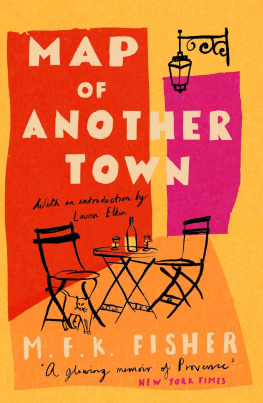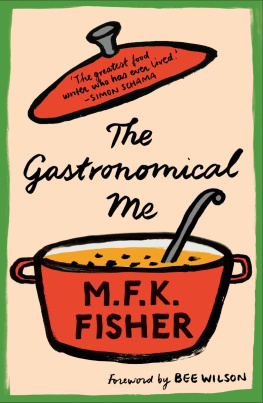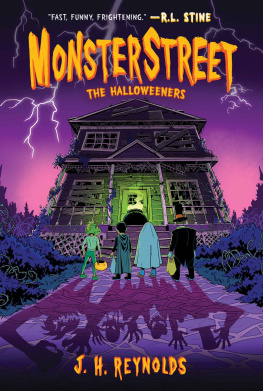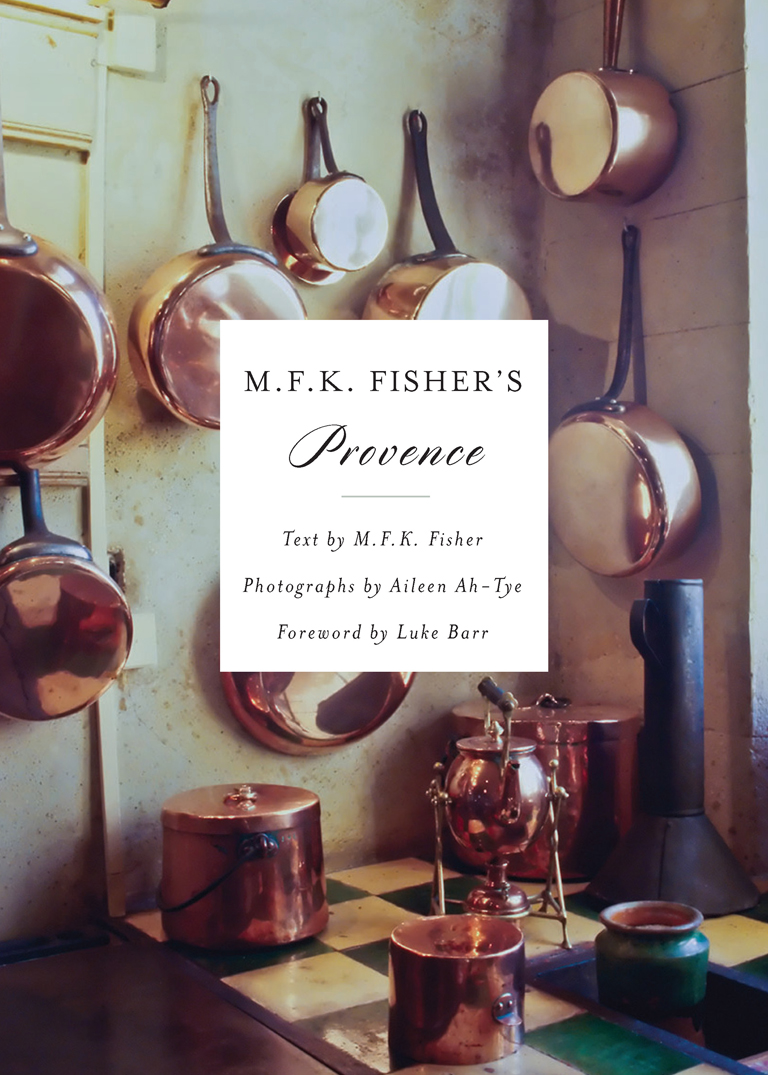M.F.K. FISHERS PROVENCE

PLATE ONE La Rotunde, Cours Mirabeau

Copyright 2015 Aileen Ah-Tye
All rights reserved under International and Pan-American Copyright Conventions. No part of this book may be used or reproduced in any manner whatsoever without written permission from the publisher, except in the case of brief quotations embodied in critical articles and reviews.
Library of Congress Cataloging-in-Publication Data Is Available
Cover design by Kelly Winton
Interior design by Gopa & Ted2. Inc.
Counterpoint Press
2560 Ninth Street, Suite 318
Berkeley, CA 94710
www.counterpointpress.com
Distributed by Publishers Group West
10 9 8 7 6 5 4 3 2 1
e-book ISBN 978-1-61902-667-4
For John Davidson
Contents

Guide
Simple Pleasures in Aix-en-Provence

W E SHOPPED morning, noon, and night in Provencewe shopped for croissants, baguettes, newspapers, and cigarettes, for tomatoes, peaches, string beans, strawberries, eggplants, mushrooms, and lettuce. We shopped for legs of lamb and chickens, for cubes of beef for stew, and for pork sausages. We shopped for butter and milk and cheese, and for honey and cases of wine and Badoit mineral water. We shopped for breakfast, lunch, and dinner, and then we started over again.
For basic provisions, we went into the villageour house was in tiny Puyricard, on the outskirts of Aix. The town had an old stone church next to the post office, three bakeries, a little Casino supermarket, a butcher, and a caf with vaguely unfriendly, pastis-drinking middle-aged men, the kind that can be found in every French village. Sometimes they played ptanque.
I never did figure out which bakery had the best croissants, and it didnt matter, they were all good. We bought them eight or ten at a time: not too big, buttery but not overly rich, satisfyingly crunchy but still tender and elastic inside. At the newsstand wed pick up the International Herald Tribune and Lquipe, the sports tabloid. We got to know the mom, pop, and son who ran the supermarket and who did their best to help find what we needed, with mixed success (dried red-pepper flakes?... Non, came the reply, heads shaking sadly). The butcher was hip and friendly, in his thirties but his close-cropped hair already going gray. His lamb chops were incredible.
And so it was that we developed a routine, a rhythm, a kind of easygoing daily schedule, loosely correlated to hunger and appetite. The main event was the farmers market in downtown Aix. On the Place Richelme, under the shade of a canopy of tall plane trees, this was a farmers market to end all farmers markets. Not that it was very big, or particularly fancy, but it was idyllic; the market was busy from early morning until just after lunch, full of sturdy matrons pulling two-wheeled carts and parents pushing strollers, the hustle and flow of commerce. The vegetables were beautifuldensely colored peppers, eggplants, and tomatoes, fresh garlic, yellow string beansand the fruits were even more beautifulsmall, sweet strawberries, baskets of red currants, figs, and apricots, all sorts of peaches, nectarines, plums, and melons. One man sold goat cheeses, aged to different vintages, and honey; another had hams and salami, including a heavy and rectangular aged lonzo from Corsica. We sliced our pieces thin, so it would last longer.
I have every reason to love the market in the Place Richelme: I inherited a love for it, indeed, for Aix itself. My father lived here when he was a kid in 1959: my grandmother Norah Barr brought her three sons and rented a house not far from her sister, M.F.K. Fisher, who had rented a place just outside Aix with her two daughters. I grew up hearing about this epic trip, and an earlier one in 1954from my father and uncles, mostly, about the boat ride from California down through the Panama Canal and across the Atlantic; about learning French in school in Switzerland and then moving to France for the other half of the year, attending the same lyce Paul Czanne had.
M.F. by this point was a well-established writer, and she recorded the trip in subsequent yearsin 1964 in Map of Another Town, for example, a book about Aix. She described the green light that filtered through the plane trees above the market at Place Richelme in an essay for The New Yorker in 1966: Perhaps some fortunate fish have known it, but for human beings it is rare to float at the bottom of the deeps and yet breathe with rapture the smells of all the living things spread out to sell in the pure, filtered, moving air.
Rereading her today, its often striking how little has changed. Fifty years later, the market is precisely as she described it, minus the ducklings bright-eyed in their crates and other livestock. Then again, in many other ways Aix has also changed completelyand so what if it has? Im not going to pretend to be nostalgic about 1959hell, I was born in 1968. But on this trip I was accompanied by my father and my grandmother, and I did want to see the city through their eyeshowever momentarily, in whatever glancing, refracted way, to have a visceral sense of a past that lives on embedded in the present. But the strange thing is thats not what happened at all. Or at least not the only thing.
THE HOUSE WE RENTED came with a rabbit, and of course the kids loved him. He was plump and brown, and lived in a rather elegant wood-and-stone-framed cage underneath the fig tree. We fed him carrots, and joked about eating him for dinner.
Our bedrooms were on the second floor of the 300-year-old mas, a solidly constructed stone building covered in vines and with terra-cotta-tiled floors. The kitchen was simple and spare, and had a long, zinc-topped table at its center and a door that opened out onto the graveled courtyard. In the morning I would walk out, say hello to the rabbit, and sit on one of the rickety chairs at the rickety wood-slat table, or on a creaking canvas lounge chair under the enormous plane tree, and drink my coffee. Who was driving into town, and how many baguettes did we need?
The grounds were magnificentsprawling lawns; olive, apple, plum, fig, and unruly cypress trees; lavender and rosemary bushes all overthe lavender positively thrumming with beeswhite and dark pink laurel, grapevines, and potted lemon trees; a ptanque court, a ping-pong table, a fabulous and overgrown herb gardendry, fragrant thyme and sage, basil, lemon verbena, and three varieties of rosemarya pristine pool and a pool house with a chimneyed charcoal grill and a large dining table.
Some combination of the dry heat and the easy back-and-forth from inside to outsidethe screenless doors and windows were always open, with warm breezes, children, and the occasional grasshopper making their way in and out of the housereminded me of California. My grandmothers house in Sonoma, the house I grew up loving, had a similarly overgrown and carelessly beautiful garden, a row of tall poplar trees, a scruffy lawn, and flower and vegetable plantings overlooking the Russian River and the Pacific Ocean. Inside were cats and a dog, threadbare Oriental carpets, a large kitchen, and endless evening bridge games. M.F.s house in Glen Ellen was a little more formal, a thick-walled palazzo set back from the road overlooking a field of grapevines, but both of them epitomized for me a sort of genteel, unpretentious, and yet highly sophisticated California style.














